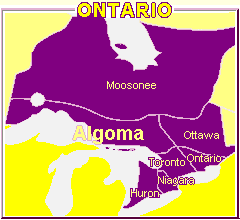 |
Frederick Dawson Fauquier (1817 - 1881) |  |
 Frederick Dawson Fauquier (1817-1881) was the first Bishop of the Anglican Diocese of Algoma.
He was consecrated in 1874.
Frederick Dawson Fauquier (1817-1881) was the first Bishop of the Anglican Diocese of Algoma.
He was consecrated in 1874.
The following account is from: History of the Church in Eastern Canada and Newfoundland by John Langtry, M.A., D.C.L., Rector of S. Luke's, Toronto, and Prolocutor of the Provincial Synod of Canada published in 1892 by the Society for Promoting Christian Knowledge. Algoma being a Missionary Diocese, its Bishop is chosen by the Provincial Synod. When therefore the Diocese of Algoma was first set apart in 1873, that Synod elected the Rev. Canon John Philip DuMoulin*, now Rector of St. James Cathedral, Toronto, to be the first Bishop of the new Diocese. After some hesitation he declined the appointment, and the next year the Rev. Frederick Dawson Fauquier, incumbent of Zorra, near Woodstock, was elected. The new Bishop was a man of refined feeling and courteous manners; humble-minded, devout, full of faith and of good works. He was not naturally an able speaker, but he devoted himself with such simple-hearted earnestness to the duties of the office to which he was called, that he soon became an efficient administrator, and won the hearts of all his people by his gentle, loving ways. He had in a high degree the character of fatherliness about him, was so sympathetic and tender-hearted, that few men have ever left behind them a memory at once so loved and so revered.  During the eight years of his episcopate the number of clergy increased from seven to fourteen, and that of church buildings from nineteen to forty-two.
But the good Bishop's faith and patience were sorely tried during his whole episcopate by a combination of difficulties.
In the first place the Diocese is of such vast extent, stretching along the shores of Lakes Huron and Superior, and away through the rocky woodlands to the Lake of the Woods, a distance of not less than 1200 miles, and running back in a limitless way to Labrador and the Hudson Bay.
The region is for the most part an unbroken forest, with scattered bands of Indians here and there throughout its vast extent.
The white settlers are gathered for the most part at favoured spots along the shore and on the numerous islands.
During the episcopate of the first Bishop there were no railways in the Diocese, now it is traversed through its whole length by the C. P. R., and the Sault line runs across a large part of it.
There were steamers in the summer in those early days, but as they did not touch at half the places the Bishop wished to reach, he had to perform the greater part of his necessary journeying, constantly exposed to severe weather and great perils, in an open boat.
Then the smallness of his own income, and the scantiness of the funds placed at his disposal by the Church, filled him with continual anxiety for the support of the scattered missionaries.
Then, again, there followed him through all his journeyings the sorrowful remembrance of his suffering wife, a lady of unusual refinement and ability, but who for the last twenty years of her life was an almost helpless invalid.
And last, but not least, among his trials, the fact that he himself was suffering from a painful internal disease, of which no one outside his own family was ever aware, until, the close of Dec. 1881, it almost instantly terminated his earthly life.
During the eight years of his episcopate the number of clergy increased from seven to fourteen, and that of church buildings from nineteen to forty-two.
But the good Bishop's faith and patience were sorely tried during his whole episcopate by a combination of difficulties.
In the first place the Diocese is of such vast extent, stretching along the shores of Lakes Huron and Superior, and away through the rocky woodlands to the Lake of the Woods, a distance of not less than 1200 miles, and running back in a limitless way to Labrador and the Hudson Bay.
The region is for the most part an unbroken forest, with scattered bands of Indians here and there throughout its vast extent.
The white settlers are gathered for the most part at favoured spots along the shore and on the numerous islands.
During the episcopate of the first Bishop there were no railways in the Diocese, now it is traversed through its whole length by the C. P. R., and the Sault line runs across a large part of it.
There were steamers in the summer in those early days, but as they did not touch at half the places the Bishop wished to reach, he had to perform the greater part of his necessary journeying, constantly exposed to severe weather and great perils, in an open boat.
Then the smallness of his own income, and the scantiness of the funds placed at his disposal by the Church, filled him with continual anxiety for the support of the scattered missionaries.
Then, again, there followed him through all his journeyings the sorrowful remembrance of his suffering wife, a lady of unusual refinement and ability, but who for the last twenty years of her life was an almost helpless invalid.
And last, but not least, among his trials, the fact that he himself was suffering from a painful internal disease, of which no one outside his own family was ever aware, until, the close of Dec. 1881, it almost instantly terminated his earthly life.
First Anglican Bishops in Ontario *External Links: In 1896 in his book The Bishops of the Church of England in Canada and Newfoundland Charles Henry Mockridge wrote biographical sketches of Frederick Dawson Fauquier and John Philip DuMoulin |
||
 |
||
